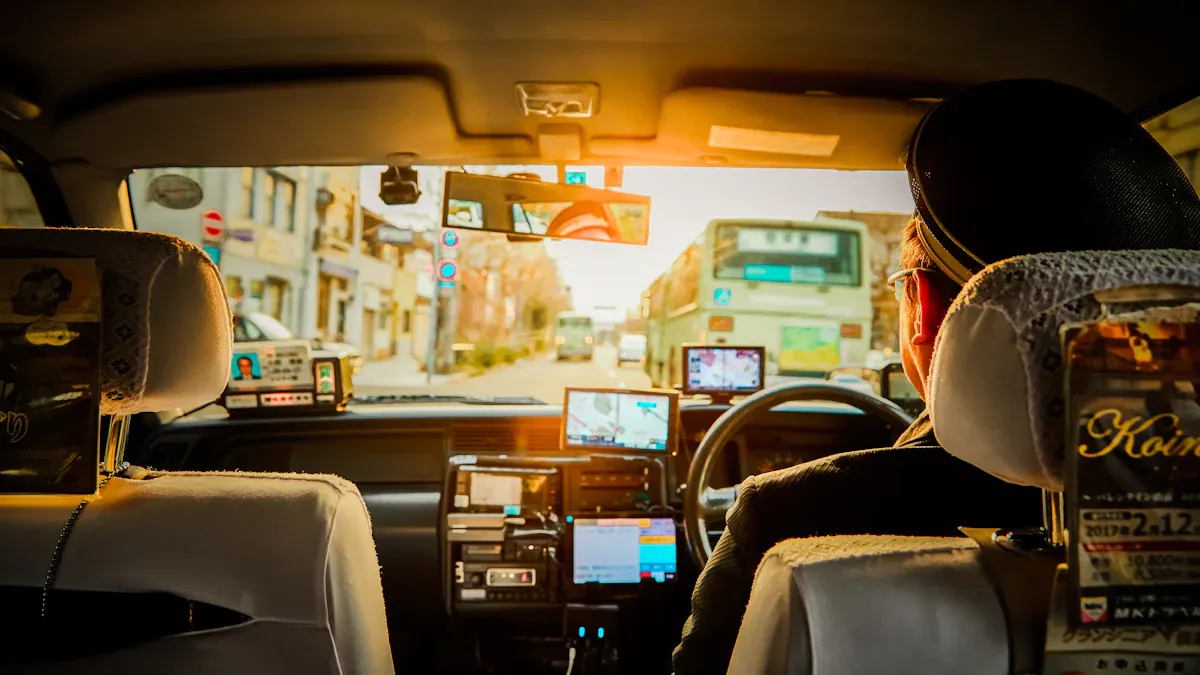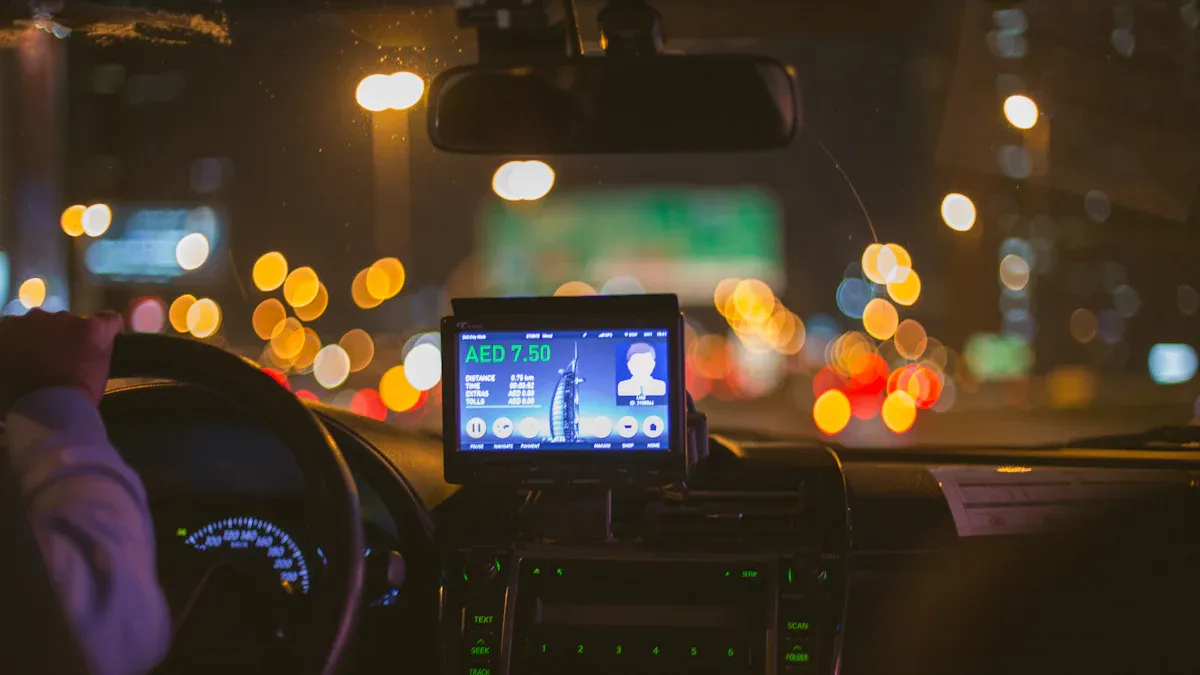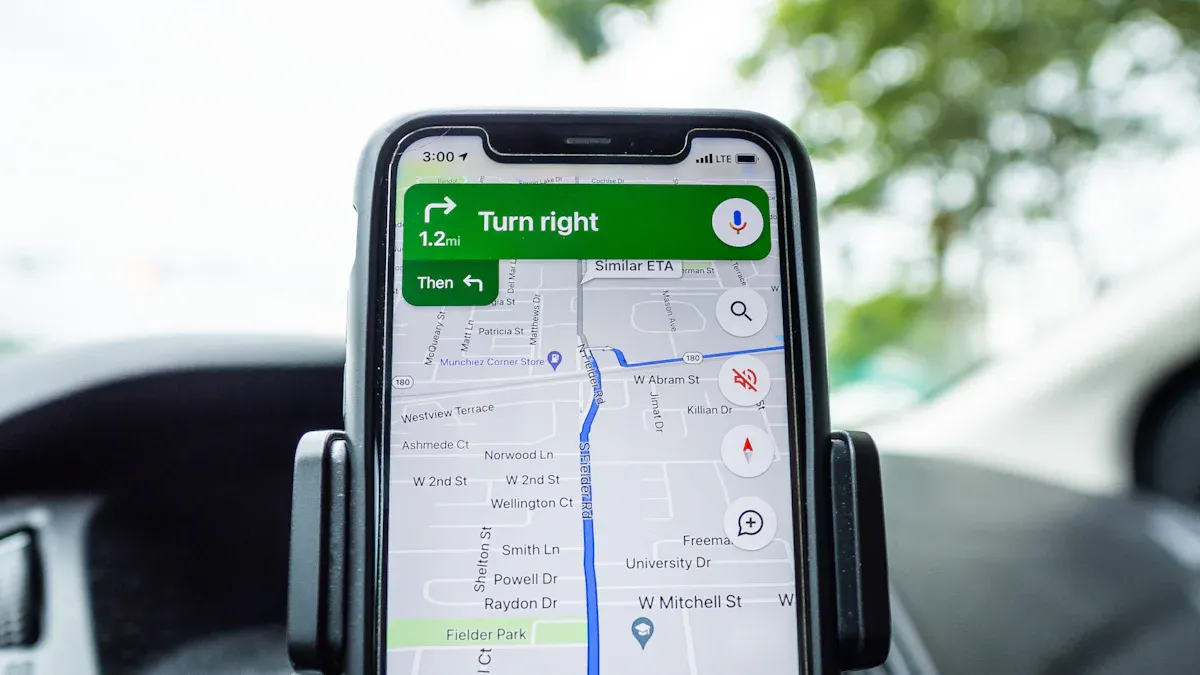
Have you ever thought about how a gps location-triggered taxi lcd screen knows when to change what it shows as a cab drives by a busy shopping area or airport? Each taxi has a GPS module. This module finds the car’s exact spot by reading coordinates. It talks to a microcontroller. The gps location-triggered taxi lcd screen uses this live data to quickly change ads or info based on where the car goes. Geo-fencing technology sets off special messages for certain areas. This makes each ride more useful for riders and advertisers.
Key Takeaways
GPS modules find the taxi’s exact spot with satellite signals. This makes the screen change what it shows by itself. Geo-fencing creates invisible lines around places. The screen then shows ads or info that fit where the taxi is. The control unit changes the screen in real time. It can get updates from far away using cellular networks. Real-time updates keep ads new and useful. This makes the ride better for passengers. It also helps advertisers reach the right people. Central monitoring lets workers control many taxi screens at once. This keeps things safe, helps people talk easily, and makes sure ads show up well.
System Components

A gps location-triggered taxi lcd screen system has many important parts. All these parts work together. They help show real-time, location-based content to people riding in the taxi.
GPS Module
The GPS module is a very important part of the system. It gets signals from satellites. It figures out where the taxi is by reading these signals. The module uses NMEA sentences like $GPGGA to find latitude and longitude. It sends this information to the control unit using a serial connection. The GPS module has an LED that blinks when it finds a satellite. This means it has a good signal. This helps the system follow the taxi’s movement. It also helps change what is shown on the screen at the right time. In gsm and gps based vehicle tracking, the GPS module works with other modules. It sends location data for real-time updates.
LCD Screen
The LCD screen shows ads, maps, and other info to people in the taxi. Most taxi screens are 10.1 inches and use an IPS panel. The resolution is 1280 x 800 pixels. These screens are bright and respond quickly. They last a long time, over 50,000 hours. Many screens let you touch them and have stereo sound. The LCD screen is clear, strong, and can show interactive content.
Tip: The table below lists common LCD screen specs:
Specification | Typical Value |
|---|---|
Panel Size | 10.1 inch IPS LCD screen |
Resolution | 1280 x 800 pixels |
Brightness | 300 cd/m² |
Touch Screen | Capacitive 5-point touch |
Audio Output | Stereo L/R, 5W x 2, 8Ω |
Panel Life | Over 50,000 hours |
Control Unit
The control unit is like the brain of the system. It handles GPS data and controls what is on the LCD screen. The control unit changes ads and info based on where the taxi is. It can be managed from far away using a computer or phone. With 4G or Wi-Fi, it can get updates and send reports. Some control units can control groups and set ad times. This makes them good for different ad campaigns.
Main features of the control unit:
Can be managed from far away
Works with GPS and 4G modules
Easy to fix and check
Software
Vehicle tracking software connects all the hardware. It manages what is shown, sets ad times, and checks if the system works well. Many systems use cloud platforms. These support many languages, interactive media, and give detailed reports. The software uses GPS data to show ads by place and time. It can connect to central dispatch and get updates by Wi-Fi, 4G, or 5G. Some platforms have extra features like motion sensors, custom CPM rates, and work with ad networks. Vehicle tracking software makes sure the right message shows up in the right place at the right time.
How gps location-triggered taxi lcd screen Works
Location Detection
A gps location-triggered taxi lcd screen begins by finding the taxi’s exact spot. The system uses a GPS module to get gps coordinates from satellites. This module follows the taxi as it moves on its path. It reads longitude and latitude right away. Many new systems use both GPS and BDS satellites. These systems can find the taxi’s spot within 2.5 meters. This high accuracy lets the screen change fast when the taxi enters new places.
Note: Good location detection keeps passengers safe and helps ads work better.
Aspect | Description |
|---|---|
System | |
Location Detection | Uses longitude and latitude coordinates |
Real-time Tracking | Continuously updates taxi’s position and expected arrival times |
Accuracy | Up to 2.5 meters with advanced GPS/BDS technology |
Technology | Differential GPS and wireless data communication |
Content Triggering
After the system knows where the taxi is, it uses geo-targeting to show content. Operators set up geofences, which are invisible lines around city spots. When the taxi goes into a geofenced area, the gps location-triggered taxi lcd screen changes what it shows. For example, if the taxi enters Midtown Manhattan, the screen might show ads for local food or events. When the taxi leaves, the screen goes back to normal ads. This way, riders see info that matches their trip.
How geo-targeting works:
The system follows the taxi’s real-time spot using GPS transponders.
Operators draw geofencing shapes around special places.
The control unit connects certain ads or messages to each geofence.
When the taxi enters a geofenced place, the screen shows content for that spot.
The screen goes back to regular ads when the taxi leaves.
Geo-targeting uses a hexagonal geospatial indexing system to split big areas into small zones. This helps advertisers aim at moving taxis with great accuracy. The system can show changing, location-based ads as the taxi drives through different parts of the city.
Real-Time Updates
The gps location-triggered taxi lcd screen needs real-time updates to keep content new and useful. The control unit gets GPS data all the time and acts on it right away. As the taxi moves, the system checks its gps spot with the list of geofenced places. If the taxi takes a new path or enters a new area, the screen changes right away. This real-time gps tracking makes sure riders always see the best ads or info.
Digital signage software handles these updates using cloud tech. Operators can change ads, update times, or check the system from one dashboard. The system also saves data on which ads show and when. This helps advertisers see how well their ads do and plan better for next time.
Tip: Real-time content helps advertisers reach people in the right place at the right time.
Vehicle Tracking System Integration
Data Communication
Taxi LCD screens talk to the vehicle tracking system using cellular networks. The system often uses a D828 Push-to-Talk over Cellular (PoC) device. This device connects the taxi to the vehicle tracking system and central dispatch. It works with 2G, 3G, or 4G networks. The connection lets the system send location, voice, and status data right away. The vehicle tracking system uses mobile networks to send info fast and safely. Drivers and dispatchers talk using TASSTA, ZELLO, and Real PTT. The LCD screen gets updates about driver status and vehicle location in real-time. This setup helps the vehicle tracking system manage the fleet well. The gsm and gps based vehicle tracking method keeps each taxi connected, even in busy city streets. Real-time data makes the system quick and correct.
Central Monitoring
A central monitoring platform controls all taxi LCD screens and their content. The vehicle tracking system uses a cloud-based Content Management System (CMS) to control screens from far away. Operators can send ads, news, and weather updates to any taxi right away. The CMS collects data like ad clicks and screen status for study. Taxi companies check the working status of every screen from one dashboard. The vehicle tracking system supports ads based on where the taxi is. This way, content matches the taxi’s current area. Passengers can interact with ads or information using special features. The central platform uses real-time data from the vehicle tracking system to change content fast. Vehicle tracking software helps operators look at reports and plan new campaigns. The system makes sure every taxi gets the right message at the right time.
Note: Central monitoring makes the fleet safer, helps ads reach the right people, and gives passengers a better ride by using real-time data from the vehicle tracking system.
GPS Vehicle Tracking System Technology
GPS Trilateration
A gps vehicle tracking system finds where a taxi is by using GPS trilateration. This method checks how far the taxi is from at least three satellites. The system compares these distances to figure out the taxi’s spot. GPS trilateration gives very exact details about movement, direction, and speed. The system can find a taxi within a few meters or even closer. This accuracy is important for taxi LCD screens. Passengers get real-time updates because the system always knows the taxi’s location. The gps vehicle tracking system uses gps coordinates to show the right info at the right time.
Note: Good tracking helps the system show the best ads and updates to passengers.
Microcontroller Role
The microcontroller is the main processor in a gps vehicle tracking system. It connects to the GPS module and gets raw data in NMEA format. The microcontroller looks for the $GPGGA sentence, which has important details like latitude and longitude. It reads this data, saves the values, and updates the LCD screen with the newest location. The microcontroller also talks to other modules, like GSM, to send alerts or location updates. It controls how information moves and makes sure the system reacts fast. These features help the gps vehicle tracking system work well for drivers and passengers.
Connectivity
A gps vehicle tracking system needs strong connectivity to work right. Most systems use cellular networks, like 4G, to send data quickly. Each tracking device has a SIM card that connects to the network and sends location data to cloud servers. Operators can see this data on mobile or desktop apps. The system gets power from the taxi’s battery and connects to vehicle systems for more data. New features like 5G and extra sensors make the system better. 5G lets data move faster and helps LCD screens show interactive content. Sensors help the system notice changes in the vehicle and give new features to passengers. These upgrades make the gps vehicle tracking system stronger and more flexible.
Example Scenario

Passing a Landmark
A taxi moves down a busy street. The driver follows a set path with famous places. As the taxi gets close to a big museum, the GPS module finds the exact spot. The control unit gets this info and checks if the taxi is in a geofenced area. The system sees the museum as an important stop. The LCD screen gets ready to change what it shows.
The system uses live GPS data to follow the taxi. This helps show the right info at the best time. The driver does not have to do anything. The technology does all the work by itself.
Dynamic Content Change
When the taxi enters the museum’s geofenced zone, the LCD screen quickly shows an ad for a café nearby. The ad fits the taxi’s spot and where it is going. If the taxi keeps going to the city center, the system gets new ads ready for the next places. The software picks the best ads for each spot using special methods.
Here is a table that shows how the screen changes for each place:
Landmark | Screen Content | Route Direction |
|---|---|---|
Museum | Café Ad | Northbound |
Stadium | Sports Store Promotion | Eastbound |
Park | Outdoor Event Announcement | Southbound |
The system changes the screen as the taxi moves. This makes the ride better for passengers and helps ads reach the right people. The technology uses route info and smart methods to show messages at the right time and place.
A vehicle tracking system uses GPS and 4G modules to track taxis in real time. It can control many taxi LCD screens at once. The system changes ads by itself and lets people manage content from far away. It also sets when ads play based on where and when the taxi is. Some important features are saving energy, stopping theft, and being tough. Drivers and riders get updates right away, feel safer, and see helpful info. The system helps people talk better and makes routes faster. In the future, screens will let people interact more, use smart data, and work with smart city tech in real time.
FAQ
How does the taxi LCD screen know when to change content?
The system checks the taxi’s spot using GPS data. When the taxi goes into a set area, the control unit tells the LCD screen to show new ads or info for that place.
Can operators update screen content remotely?
Operators can change ads and info from a main dashboard. The system uses cellular networks to send updates to each taxi. This keeps the content new and right for every rider.
What happens if the GPS signal is lost?
If the GPS signal is lost, the control unit uses the last spot it knew. The system keeps showing the latest content until the signal comes back. This helps keep the ride smooth for passengers.
Are these screens interactive for passengers?
Many taxi LCD screens let you touch them. Passengers can use ads, maps, or local info. This makes the ride more fun and helpful.
How secure is the data sent between taxis and the central system?
The system uses safe, encrypted messages over cellular networks. This keeps location data and updates private. Taxi companies watch security to protect passenger info.
See Also
Best Motorcycle GPS Units Featuring CarPlay And Android Auto
Five Best E90 CarPlay Displays Suitable For All Budgets
Budget-Friendly Portable CarPlay Solutions For All Drivers
Audi CarPlay Screens Inspired By Tesla Compared By Price And Features
How To Enable CarPlay In Older Mercedes Vehicles Step-By-Step
